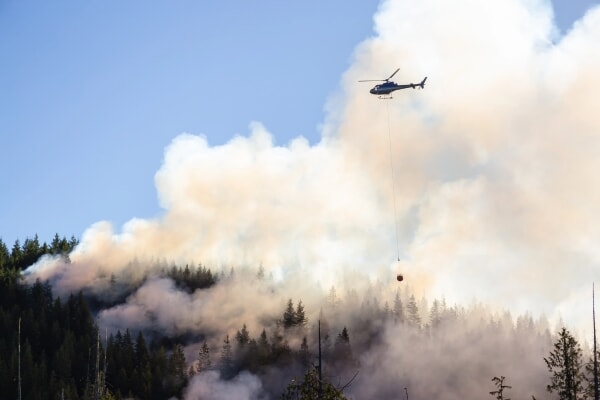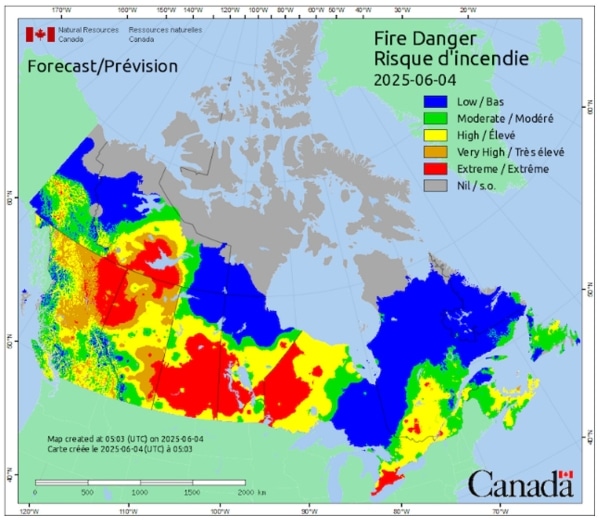Canadian Wildfire Smoke Chokes Air, Posing Serious Risks for Everyone, Especially Older Adults

You might remember the old tune Smoke from a Distant Fire—a bittersweet love song about warning signs you can’t ignore. This summer, the smoke isn’t from a heartbreak, and it’s anything but distant. It’s drifting into your lungs, your home, and, for many older adults, into already fragile health.
In affected areas, the air quality is impossible to miss. Step outside and you may catch the faint scent of smoke in the air. Local radio and TV stations are warning residents about the unhealthy conditions.
The thick haze from Canada’s record-breaking wildfires has traveled hundreds of miles, crossing borders and settling over communities far from the flames. And for people with heart or lung disease, the danger is real and immediate.
The Wildfire Situation: A Record-Breaking Season—and Smog You Can Feel
Canada is battling over 700 active wildfires as of August 8, 2025, with nearly two-thirds burning out of control. Over 6.6 million hectares is roughly 16.3 million acres—an area larger than West Virginia, marking a staggering 140 percent increase compared to last year.

But how harmful is that smoke?
Wildfire smoke contains this mixture of particulate compounds, we call it PM2.5, or this fine particulate matter, plus a whole host of other stuff is released when trees burn, and all of those can cause harm to the lungs as well as other organs too. — Maeve MacMurdo, M.D., pulmonologist at Cleveland Clinic.
The smoke is crossing continents and driving air quality to dangerous levels:
- Chicago – Recorded the world’s worst air quality last week, with AQI readings spiking to 171, fueled by a combination of wildfire smoke and ground-level ozone.
- Minneapolis – Hit second-worst globally with an AQI of 159, considered “unhealthy for all”.
- Detroit – Reached AQI 159, prompting statewide alerts.
- New York & Boston – Saw hazy skies and AQIs above 150, with advisories for more than 81 million Americans under smoke-related air quality warnings.
Even cities far from the fires—like Toronto and Montreal—recorded “very unhealthy” levels, ranking among the worst in the world.

Dr. MacMurdo explained that air quality alerts use a color-coded system to show the public how polluted the air is.
For example, green indicates safe conditions, while orange and red signal unhealthy air. Dr. MacMurdo noted that it’s not only people with lung problems who need to be cautious—those with heart conditions are also at risk, as smoke can trigger inflammation throughout the body. In severe cases, even healthy individuals can be affected.
Why Older Adults and Those with Chronic Illness Are Most at Risk
Wildfire smoke contains PM2.5 particles—microscopic pollutants that slip past your body’s defenses and lodge deep in the lungs.
They can:
- Trigger asthma attacks and COPD flare-ups.
- Increase risk of heart attack and stroke.
- Cause fatigue, confusion, or dangerously low oxygen levels.
Even brief exposure to wildfire smoke can be dangerous for people with existing respiratory or cardiovascular conditions. — Dr. Sarah Henderson, scientific director of environmental health at the British Columbia Centre for Disease Control (BCCDC).
Dr. MacMurdo says that as air quality gets worse, even if you don't have lung problems, you can start to cough and can feel a little short of breath.

You can feel like your nose is running, like you might have allergies. And at really high levels it can make you feel really short of breath even when you don't have lung problems. So basically, the worse the air quality gets the more we all feel it. — Dr. Maeve MacMurdo.
Older adults are especially vulnerable. Immune systems weaken with age, and recovery from respiratory irritation or oxygen depletion can take longer, sometimes weeks.
Special Considerations for People on Supplemental Oxygen
If you or a loved one uses oxygen for COPD, emphysema, pulmonary fibrosis, or another respiratory illness, wildfire smoke can quickly make breathing harder.
Key precautions:
- Avoid unfiltered oxygen outdoors. Always use oxygen indoors when possible, with air purifiers running.
- Check and replace oxygen tubing filters—smoke particles can reduce airflow.
- Have backup tanks or portable concentrators in case of power outages.
- Talk to your respiratory therapist before adjusting flow rates.
What Home Caregivers Can Do
If you’re caring for an older adult at home during a smoke event:
- Seal the indoor environment. Shut windows, block door gaps, and use high-efficiency filters.
- Track symptoms. Use a pulse oximeter and log oxygen saturation, breathing patterns, and fatigue levels.
- Coordinate with healthcare providers. Don’t wait until symptoms worsen.
- Plan outings carefully. Limit outdoor trips and use N95 masks for necessary appointments.
Does your loved one need a professional caregiver? You can search for caregivers or long-term care facilities by using the LTC News Caregiver Directory. LTC News can help process claims from any Long-Term Care Insurance policy. LTC News, in partnership with Amada Senior Care, a nationally recognized in-home health care agency, ensures that you and your loved ones receive the benefits from an LTC policy so your loved one gets the quality care they deserve. This service comes at no cost or obligation - Filing a Long-Term Care Insurance Claim.
How Long-Term Care Facilities Can Protect Residents
Facilities must take extra measures to keep residents safe:
- Upgrade HVAC filtration to MERV 13 or higher, run in recirculation mode.
- Check AQI daily and adjust activity schedules accordingly.
- Move programs indoors during high-smoke days.
- Increase vital checks for residents with respiratory or heart disease.
- Update families on air quality and resident health.
How to Track and Respond to Air Quality Changes
- Monitor AQI – Use AirNow.gov, IQAir, or local alerts.
- Know your thresholds – AQI over 100 is unhealthy for sensitive groups; over 150 is unhealthy for all.
- Create a clean room – Dedicate one space with a HEPA purifier running continuously.
A Changing Reality
In New Hampshire, there have already been eight air quality alerts this year—six tied to Canadian smoke (NHPR). Experts warn these events are no longer rare. Warmer, drier conditions are fueling longer, more intense wildfire seasons.
If you’re an older adult—or care for one—it’s time to prepare, not just react. Stock filters, keep masks on hand, and make AQI checks as routine as checking the weather.
Your Takeaway: The smoke from this “distant fire” is in your neighborhood, your lungs, and your loved ones’ lives. With the right precautions, you can reduce the risks—even when the skies turn gray.


